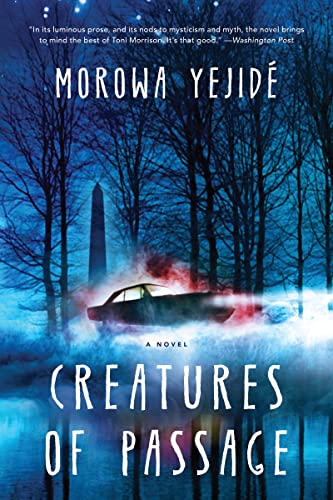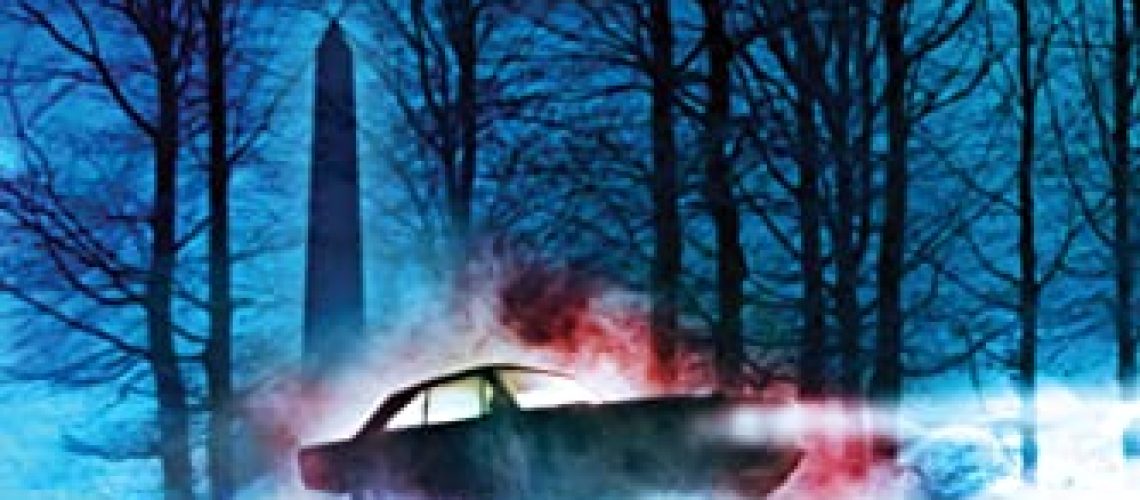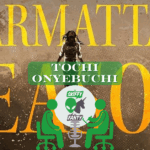From its opening pages, the surreal atmosphere of Morowa Yejidé’s exceptional, otherworldly novel Creatures of Passage envelops readers in a hazy pairing of familiarity and disorientation. Set in the Anacostia neighborhood of SE Washington D.C. during the late 1970s, the locality serves as a character within the story itself. Anacostia is a haunt in all senses of that term, a home for people who interact with its landscape and history and who are in turn changed by the mysteries of its nooks and crannies, the unforgettable soul of its core. It exists as a porous, liminal zone between the real and the fantastic, an enclave of traditions apart from the well-known Washington D.C. and lands beyond.

“…Anacostia was still the New World, an isle of blood and desire. It was the capital’s wild child east of a river that bore its name, a place where much was yet discovered. Anything was possible in the easternmost quadrant, where all things lived and died on the edges of time and space and meaning. It was a realm of contradictions, an undulating landscape of pristine land and dirty water, of breathtaking hills and decimated valleys… I’ll tell your mama was the universal threat, because next to God there was none more powerful. And the damnation and glory of man was forever intertwined in Anacostia, since all who lived there were faced with the unconquerable presence of both.”
Yejidé heightens this uncanny surreality immediately with reference to the Kingdoms of America and its rulers. For a brief time the reader may wonder if Creatures of Passage exists as an alternate history, before realizing that no, this is just the character’s way of speaking about the states of the nation and its government, a point-of-view that seems off, yet rings true. This serves particularly well in establishing the perspective of the novel’s Anacostian protagonists as descendants of the African-American Gullah, as people with distinct traditions steeped in West African cultures, and a certain independent disregard for the political system they have been stolen and forced into. Within this isolated land persists not just a blending of mythologies and practices, but a mixing from fissures in time and space, a passage through doors between life and death. All arise from a view of the world that contrasts from the accepted states of understanding in the lands of America beyond, and from the need to confront memories both collective and personal.
Nephthys Kinwell drives the night-darkened back streets of Anacostia in her 1967 Plymouth Belvedere, compelled and drawn towards picking up endangered passengers who need safe passage through the foggy night and risks to their lives. This supernatural connection and service comes only with circumstances that haunt Nephthys literally and metaphorically. The ghost of a dead white girl resides in the trunk of the car, thumping. And the memory of her murdered twin brother Osiris resides in her mind, with the pain of a lost connection that she dampens with alcohol and solitary estrangement from her only living family.
That family consists of Osiris’ daughter Amber and Amber’s ten-year-old son Dash, and the ancestral magic that manifests in Nephthys also can be found in them. Amber can foresee deaths in her dreams, an ability that people both seek out and fear from her. Nephthys has become embittered by the failure of her niece’s ability to foresee and prevent the mysterious death of Osiris. But now, Amber has foreseen something concerning her son Dash, and is unsure how to proceed.
Unknown to both women, Dash’s troubles stem from having witnessed malicious activities from the school caretaker. A school nurse worried about Dash’s behavior and Amber’s dream of premonition draw Nephthys back into her familial life and her damaged past. Meanwhile, Dash has visions of a mysterious figure along the Anacostia River, a man he interacts with who seems invisible to Dash’s mocking classmates.
The various disparate plots of Creatures of Passage come together like the porous blending of the setting and its people. They are united by darkness, which manifests both in melancholy atmosphere and the heaviness/disturbing nature of the novel’s plot, including sexual abuse of minors that some readers may have difficulty handling. Yet, the theme of Creatures of Passage rests with the transcendence of darkness and trauma by both individuals and the community as a whole, people largely left to survive on their own without systems of power and privilege that others in the world beyond may have at hand. In Creatures of Passage that transcendence only comes with an openness. An honest acknowledgement of discomforting truths and a willingness to be led by forces for the good larger than oneself, whether that is seen through the light of a deity or deities, ancestors, or pure serendipity to balance the universe.
Even with the sadness, pain, and darkness, Yejidé infuses Creatures of Passage with the hope and means to get through it all, whether on that ultimate level of Death, or smaller moments of difficult passing. She does this through the growth of her characters, particularly in Nephthys and a general achievement of Anacostian community organization/engagement to confront trauma that has created a monster in its midst. She also does it by filling the pages of the novel with beautiful, haunting prose that inspires the wonder and joy of life while still not failing to acknowledge the dark, harsh realities that accompany it.
“The blue cloudcap cleared as the evening deepened. The feral garden pulsed under the unblinking glare of the moon, the mating songs of the crickets in their legions ruling the night. The soil throbbed with the energy of its own ecosystem, and all things planted in its dark granules sprouted and shot up from the ground in an ultraviolet explosion of leaf and bulb and bounty, no matter the seed or the season. Fat cobs of early corn held a lavender luster in the lunar light, and they dropped from their stalks and plunged to the ground. Enormous basil and rosemary and oregano leaves waved in the night breeze. The starts flashed on the black surface of water buckets, and one silver canopy of vegetation cast great shadows on another.”
Yejidé pairs the rich tapestry of Egyptian and Gullah-inspired mythology with vivid imagery of color (particularly of water, in a way that the novel’s cover design captures) and an almost poetic repetition of words and phrases throughout the novel that tie to its themes and character development.
Others have likened Creatures of Passage to a vibe of Toni Morrison meets Gabriel García Márquez, and the comparison seems fair on the grand scale. Yet, Yejidé surely achieves something uniquely and personally her own here, a powerful novel that serves as both literary and speculative, a brave work that addresses dark themes head-on, unflinchingly and honestly in a way that renders the fantastic to seem the most rational thing possible. With its vivid omniscient narration, Creatures of Passage guides passage between broad societal issues and the personal psychologies that underly them.
The novel has been long-listed for the 2022 Women’s Prize for Fiction, short-listed for the Ernest J. Gaines Award for Literary Excellence, and was a 2021 Notable Book for both NPR and the Washington Post. Yejidé’s previous novel, Time of the Locust, was similarly well received, and Creatures of Passage probably deserved even greater recognition and wider readership. If any SFFH genre fans missed out on the novel to date, I highly recommend checking it out, as it strongly aligns with what Skiffy & Fanty and our listeners/readers generally appreciate.







